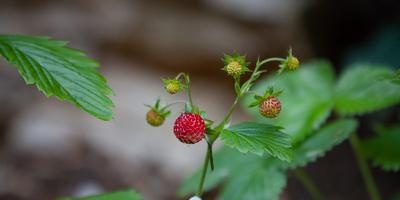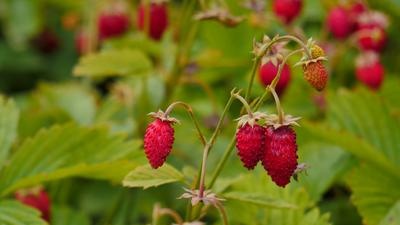|
 In 1814, the French officer Captain Frisier returned to his homeland from Chile. As a souvenir, he brought out several strawberry bushes. It was not an ordinary small-fruited berry that the French picked in the forest and planted in the garden. The Chilean was ten times larger. In 1814, the French officer Captain Frisier returned to his homeland from Chile. As a souvenir, he brought out several strawberry bushes. It was not an ordinary small-fruited berry that the French picked in the forest and planted in the garden. The Chilean was ten times larger.
In the local markets, it cost exorbitant prices.
With difficulty the captain brought his treasure - the journey by sea lasted almost six months. Several bushes from him immediately begged the botanist Duchenne from the Versailles Botanical Garden. However, the newly arrived strawberries not only did not produce large berries, but none at all. Although it bloomed perfectly. Duchenne quickly identified the cause of the infertility. All flowers are female! True, wild local strawberries grew nearby, but they turned out to be incompatible.
It was only a hundred years later that Captain Frisier's souvenir was still used. The plant was crossed with another strawberry from the New World, Virginia, and received the first seedling of a large-fruited pineapple, the same one that is grown now. Its fruits reached the size of a palm, which made gardeners in awe. True, the newly discovered treasure has retained not only its large size, but also the love of warmth.
Therefore, passengers crossing Eastern Siberia along the Trans-Siberian Railway usually do not meet this berry at the stations. They know that Eastern Siberia is dry, there is little snow in winter, and pineapple strawberries will not survive the winter without a snow coat. And how surprised the road people are when the train carries them to Lake Baikal. Even on a hot July day, Baikal breathes cold, but at the small station Vydrino, near the famous pulp mill, they are greeted by Baikal women with full baskets of pineapple strawberries. The one that is the size of a palm. And this is in the center of the huge Asian continent, where neither oak nor ash, nor their eternal companion lily of the valley grows.
The explanation is simple. Although Baikal is a huge refrigerator, a lot of precipitation falls near Vydrino station. Three times more than in rainy Moscow. There is so much snow in winter that potatoes do not freeze in the gardens. The snow also protects the strawberries. Its harvests are excellent here.
 However, for all its enviable qualities, the pineapple treasure has several weak points. First, its berries are heavy, like cucumbers, and lie on the ground. The rains splatter them with mud. And since especially large berries grow from those who generously fertilize with manure, then manure also gets onto the berries with dirt. They say that in Truskavets patients who come to the resort for treatment are warned: “Eat any greens, but be especially careful with strawberries. Wash it ten times better than anything else. " However, for all its enviable qualities, the pineapple treasure has several weak points. First, its berries are heavy, like cucumbers, and lie on the ground. The rains splatter them with mud. And since especially large berries grow from those who generously fertilize with manure, then manure also gets onto the berries with dirt. They say that in Truskavets patients who come to the resort for treatment are warned: “Eat any greens, but be especially careful with strawberries. Wash it ten times better than anything else. "
True, gardeners have come up with a remedy for dirt. They have been covering the ground with straw for a long time. The berries lie on the mat and stay clean. Therefore, the English name is not strawberry, but straw berry. Still, straw isn't the best defense. It is hygroscopic. Molds easily. Mold is the most dangerous for berries.
Various substitutes for straw were offered: oak bark, spruce needles, slate plates, wood shavings. Back in 1911, the magazine "Garden and Garden" criticized everything. Oak bark? It is porous and also stores water. The berries are rotting. Spruce needles? They stick too hard to berries. Then you cannot remove them. Moss? He is teeming with all kinds of evil spirits. Slate plates? Black spots remain from them. Wood shavings seem to be good: cheap, dry, odorless. Snails do not start in them. However, the berries will roll in them so that you will not pull it out later, everything will be crumpled. And most importantly, instead of the usual pineapple smell, the berries begin to smell like spruce resin.
Recently the English magazine "Gardens Chronicle" ("Garden Chronicle") proposed another option. You take three empty bottles and fold them in a triangle around a strawberry bush.The berries fall on the bottle glass. This is how you kill two birds with one stone. First, the berry on the glass does not get wet or moldy. Secondly, the bottles are warmed up by the sun and supply the berries with additional heat. The harvest ripens earlier. In damp, foggy England, this is especially beneficial.
However, the troubles with strawberries do not end there. Then it is damaged by a nematode - small white worms. And the bushes dry up. Then gray mold piles on - and the berries turn into dirty jelly. It happens that a gardener in despair abandons a troublesome culture. However, if he is an observant person, then he can quite easily get out of a predicament. They talk about a gardener who was very fond of strawberries, but allotted most of the area to other crops - cucumbers and onions.
The great thing was that neither cucumbers nor onion he did not use it for its intended purpose. Onion could not eat because of an innate disgust for him. He didn't even sell onions. Although he adored cucumbers, he ate little. He simply tore their whips out of the ground and threw them away. Day after day, until not a single whip remained. The neighbors made fun of the eccentric. However, they soon noticed that strawberries would be the best for him. And he never suffers from adversity.
We talked and found out the following. He plants onions among strawberries so that gray rot does not start. Onion volatiles - phytoncides - do this perfectly. Cucumbers serve as bait for nematodes. Malicious worms are given a choice: strawberries or cucumbers? They prefer cucumbers... And when they settle them properly, the gardener removes the whip, and with it the settlers. The strawberries stay clean.
 However, let's be fair. The delicate berry is not only troublesome to its patrons. It provides growers with benefits that are difficult to expect from other fruits and berries. It repairs the liver, kidneys, biliary tract, stomach and spleen. On this occasion, connoisseurs of useful plants, father and son Nosali, recalled the old saying of the physician I. Kneipp: "In the house where they eat strawberries, the doctor has nothing to do!" It is advised to eat it alone or with milk. However, let's be fair. The delicate berry is not only troublesome to its patrons. It provides growers with benefits that are difficult to expect from other fruits and berries. It repairs the liver, kidneys, biliary tract, stomach and spleen. On this occasion, connoisseurs of useful plants, father and son Nosali, recalled the old saying of the physician I. Kneipp: "In the house where they eat strawberries, the doctor has nothing to do!" It is advised to eat it alone or with milk.
With cream or sugar. But most importantly, a lot. In such quantities that you get bored. To have to force myself to eat another glass. "Do not spare money for this treasure," Nosali advise, "consider that it is as important as bread!"
True, there are people who, with all their desire, cannot afford to eat so much. And even quite a bit. They get allergic. The whole body is covered with a rash with blisters. The skin begins to itch, as if not washed for a month. Sometimes the stomach hurts and the head is spinning, as in case of poisoning. And there is even vomiting. They knew one woman who started vomiting only from one kind of plate with strawberries.
But, glorifying pineapple, one cannot forget our forest small-fruited strawberries. Although she is tiny in comparison with her cultured companion, she has a stronger and more delicate smell. And experts, if there is a choice, prefer it. However, here you also need to be careful and think before making a choice. The fact is that the XX century, which introduced perturbations in the world of plants, did not bring anything bad to forest strawberries. On the contrary, when they cut down the coniferous forest and burned the logging residues, our berries grew luxuriantly and freely on the fires. It grew even more along the roadsides. And there are many more roads.
Cars go along the roads. Exhaust gas contains lead. It accumulates in roadside soil and in plants. Probably in strawberries too. Therefore, if you are going to collect, then it is better on those roads where there are fewer cars. And even better - through forest glades, clearings or old clearings.
And now there are a few unsolved problems. The main difficulty is harvesting. Manually on large plantations is expensive and long. There is already mechanization, but, as luck would have it, the most productive varieties have a weak skin. The berries are damaged and not stored for long. They do not know what to do with fertilizers. The more fertilizers, the more berries. But the Swedes don't bring them in at all. Perhaps just a little.They are sure that you will not get a quality product otherwise!
A. Smirnov
|